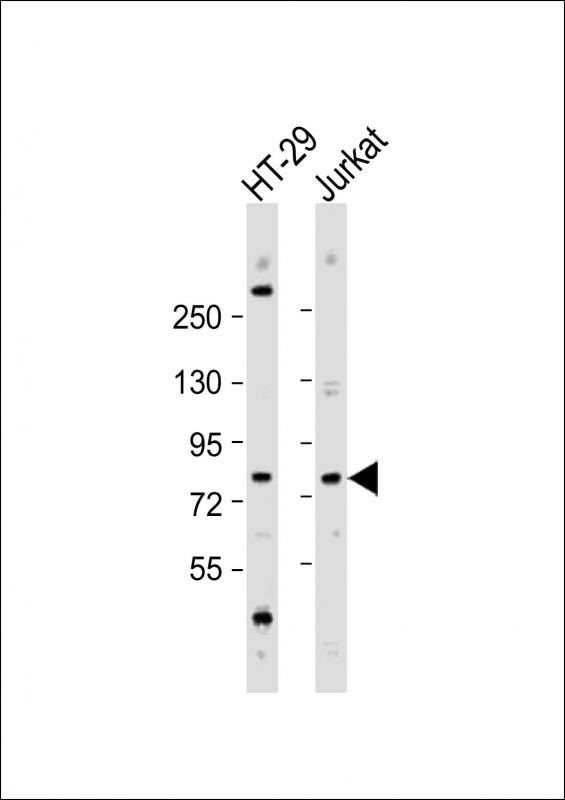ACSS1 Antibody (N-Term)
Purified Rabbit Polyclonal Antibody (Pab)
- 产品详情
- 实验流程
- 背景知识
Application
| WB, E |
|---|---|
| Primary Accession | Q9NUB1 |
| Reactivity | Human, Mouse |
| Host | Rabbit |
| Clonality | polyclonal |
| Isotype | Rabbit IgG |
| Calculated MW | 74857 Da |
| Gene ID | 84532 |
|---|---|
| Other Names | Acetyl-coenzyme A synthetase 2-like, mitochondrial, 6.2.1.1, Acetate--CoA ligase 2, Acetyl-CoA synthetase 2, AceCS2, Acyl-CoA synthetase short-chain family member 1, ACSS1, ACAS2L, KIAA1846 |
| Target/Specificity | This ACSS1 antibody is generated from a rabbit immunized with a KLH conjugated synthetic peptide between 94-125 amino acids from human ACSS1. |
| Dilution | WB~~1:2000 E~~Use at an assay dependent concentration. |
| Format | Purified polyclonal antibody supplied in PBS with 0.09% (W/V) sodium azide. This antibody is purified through a protein A column, followed by peptide affinity purification. |
| Storage | Maintain refrigerated at 2-8°C for up to 2 weeks. For long term storage store at -20°C in small aliquots to prevent freeze-thaw cycles. |
| Precautions | ACSS1 Antibody (N-Term) is for research use only and not for use in diagnostic or therapeutic procedures. |
| Name | ACSS1 |
|---|---|
| Synonyms | ACAS2L, KIAA1846 |
| Function | Catalyzes the synthesis of acetyl-CoA from short-chain fatty acids (PubMed:16788062). Acetate is the preferred substrate (PubMed:16788062). Can also utilize propionate with a much lower affinity (By similarity). Provides acetyl-CoA that is utilized mainly for oxidation under ketogenic conditions (By similarity). Involved in thermogenesis under ketogenic conditions, using acetate as a vital fuel when carbohydrate availability is insufficient (By similarity). |
| Cellular Location | Mitochondrion matrix |
For Research Use Only. Not For Use In Diagnostic Procedures.
Provided below are standard protocols that you may find useful for product applications.
BACKGROUND
Important for maintaining normal body temperature during fasting and for energy homeostasis. Essential for energy expenditure under ketogenic conditions (By similarity). Converts acetate to acetyl-CoA so that it can be used for oxidation through the tricarboxylic cycle to produce ATP and CO(2).
REFERENCES
Ota T.,et al.Nat. Genet. 36:40-45(2004).
Deloukas P.,et al.Nature 414:865-871(2001).
Mural R.J.,et al.Submitted (SEP-2005) to the EMBL/GenBank/DDBJ databases.
Nagase T.,et al.DNA Res. 8:85-95(2001).
Nakajima D.,et al.DNA Res. 9:99-106(2002).
终于等到您。ABCEPTA(百远生物)抗体产品。
点击下方“我要评价 ”按钮提交您的反馈信息,您的反馈和评价是我们最宝贵的财富之一,
我们将在1-3个工作日内处理您的反馈信息。
如有疑问,联系:0512-88856768 tech-china@abcepta.com.























 癌症的基本特征包括细胞增殖、血管生成、迁移、凋亡逃避机制和细胞永生等。找到癌症发生过程中这些通路的关键标记物和对应的抗体用于检测至关重要。
癌症的基本特征包括细胞增殖、血管生成、迁移、凋亡逃避机制和细胞永生等。找到癌症发生过程中这些通路的关键标记物和对应的抗体用于检测至关重要。 为您推荐一个泛素化位点预测神器——泛素化分析工具,可以为您的蛋白的泛素化位点作出预测和评分。
为您推荐一个泛素化位点预测神器——泛素化分析工具,可以为您的蛋白的泛素化位点作出预测和评分。 细胞自噬受体图形绘图工具为你的蛋白的细胞受体结合位点作出预测和评分,识别结合到自噬通路中的蛋白是非常重要的,便于让我们理解自噬在正常生理、病理过程中的作用,如发育、细胞分化、神经退化性疾病、压力条件下、感染和癌症。
细胞自噬受体图形绘图工具为你的蛋白的细胞受体结合位点作出预测和评分,识别结合到自噬通路中的蛋白是非常重要的,便于让我们理解自噬在正常生理、病理过程中的作用,如发育、细胞分化、神经退化性疾病、压力条件下、感染和癌症。






